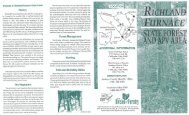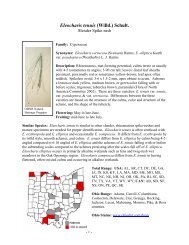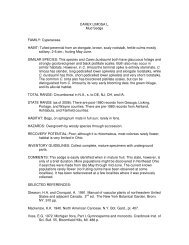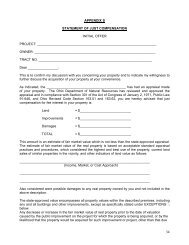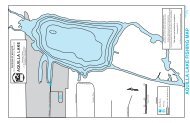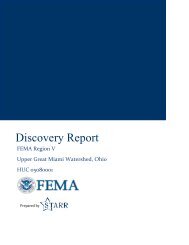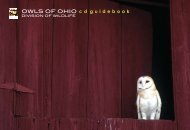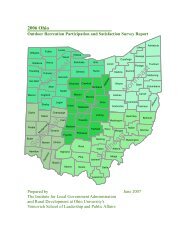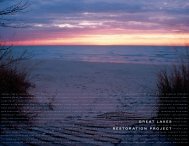Wildlife in Full Color - Ohio Department of Natural Resources
Wildlife in Full Color - Ohio Department of Natural Resources
Wildlife in Full Color - Ohio Department of Natural Resources
Create successful ePaper yourself
Turn your PDF publications into a flip-book with our unique Google optimized e-Paper software.
COLOR SCHEME: TRIADICTriadic comb<strong>in</strong>ations are composed <strong>of</strong> three hues that are distributed at equal distances on a color wheel.These schemes tend to be quite vibrant, even with pale or unsaturated hues.COLORFUL FEATHERSA bird’s feathers come <strong>in</strong> a ra<strong>in</strong>bow <strong>of</strong>colors. The colors <strong>in</strong> feathers are formed<strong>in</strong> two different ways, from pigments orfrom light refraction. Refraction is theturn<strong>in</strong>g or bend<strong>in</strong>g <strong>of</strong> light waves as itpasses from one surface <strong>in</strong>to another.If you f<strong>in</strong>d a blue jay feather, you cansee for yourself how refraction works.First, observe the feather <strong>in</strong> normallight. You should see the expected bluecolor. Next, try putt<strong>in</strong>g a light beh<strong>in</strong>d thefeather. When light is transmitted throughthe feather, it will look brown.Some birds are iridescent, which meanstheir feathers disperse many colors whenviewed at different angles and <strong>in</strong> differentlight. Take a look at the ruby throat onthe ruby-throated humm<strong>in</strong>gbird, or thesh<strong>in</strong>y head <strong>of</strong> a grackle. At first glance,it may look dark, but when the light hitsjust right, the color is brilliant!Pay attention to color patterns on birdsthe next time you are outside. Noticehow certa<strong>in</strong> field marks, like eye r<strong>in</strong>gs orw<strong>in</strong>g bars, can be very boldly colored. Thetip <strong>of</strong> the cedar waxw<strong>in</strong>g’s tail looks likeit is dipped <strong>in</strong> yellow pa<strong>in</strong>t. Not all birdswant to stand out. Some birds’ color<strong>in</strong>ghelps to “disrupt” or break up theirappearance mak<strong>in</strong>g it harder to see them.This is called disruptive coloration and isvery easy to see <strong>in</strong> birds like the killdeer.The alternat<strong>in</strong>g bands <strong>of</strong> white and blackon the head and neck break up the outl<strong>in</strong>e<strong>of</strong> the bird. This makes it more difficultto see the bird aga<strong>in</strong>st a multi-coloredbackground.CROWN/CRESTTHROATEYE LINE/RINGBREASTCHEEK/MOUSTACHESHOULDERWINGBARFLANKRUMPTAILHOW BIRDS USE COLORIn the bird world, the male is usuallythe more colorful one, and with goodreason. The male bird uses his brightcolors to attract a mate, while the female,who sits at the nest with eggs and young,does not want to be noticed. She wantsto blend <strong>in</strong> with her surround<strong>in</strong>gs and notattract predators. <strong>Color</strong> can be used tostand out and to hide!Another way that color is used <strong>in</strong>birds is to identify themselves to othermembers <strong>of</strong> their flock. <strong>Color</strong> patterns <strong>in</strong>some shorebirds and waterfowl <strong>in</strong> flightcan be very dist<strong>in</strong>ctive. The color <strong>in</strong>side<strong>of</strong> the mouths <strong>of</strong> hungry chicks stimulatesthe parents to feed the young.Any way you look at it, from names,to feathers, to even their eggs, birdsare very colorful. The next time youare outside, take note <strong>of</strong> how manydifferent colored birds you can f<strong>in</strong>d.Which bird do you th<strong>in</strong>k is “the fairest<strong>of</strong> them all?”ACTIVITY: BIRDS OF A FEATHER MATCH TOGETHERUse the pictures below to help match the feathers to the correct bird.See answers on back cover1. _______ Barn Owl2. _______ Great Horned Owl3. _______ Wild Turkey4. _______ Pheasant5. _______ Wood Duck6. _______ Mallard2011 - 2012 WILD OHIO MAGAZINE19



